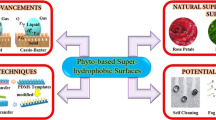Abstract
Carnivorous pitcher plants of the genus Nepenthes have evolved specialized leaves fulfilling the multi-functions of attracting, capturing, retaining and digesting the prey, mostly arthropods. Different capturing mechanisms have been proposed and discussed in previous works. The most important capture mechanism is the unique super-hydrophilic surface properties of the peristome. The combination of a hierarchical surface structure and nectar secretions results in an exceptional water-lubricated trapping system. Anisotropic and unidirectional wettability is attributed to the ridge-like surface and epidermal folding. The three-dimensional plate-like wax crystals in the hydrophobic waxy zone can further prevent the prey from escaping. The captured prey are then digested in the hydrophilic digestive zone. The hybrid species Nepenthes × Miranda was investigated in this study. The surface morphology and hierarchical microstructure were characterized by scanning electron microscope. Contact angle measurement and wetting efficiency tests were performed to determine the wettability of the peristome under fresh, nectar-free and sucrose-coated conditions with controlled temperature and humidity. The results showed that sucrose-coated peristome surfaces possess the best wetting efficiency. The structure–property–function relationship and the capturing mechanism of Nepenthes were elucidated, which could further lead to the design and synthesis of novel bio-inspired surfaces and potential applications.










Similar content being viewed by others
References
K. Koch, B. Bhushan, and W. Barthlott, Prog. Mater. Sci. 54, 137–178 (2009).
J.R. Krebs and N.B. Davies, Behavioural Ecology: An Evolutionary Approach (Chichester: Wiley, 2009).
P. Barbosa and I. Castellanos, Ecology of Predator-Prey Interactions (Oxford: Oxford University Press, 2005).
P.M. Driver and D.A. Humphries, Protean Behaviour : The Biology of Unpredictability (Oxford, New York: Clarendon Press; Oxford University Press, 1988).
L. Adamec, Bot. Rev. 63, 273–299 (1997).
V. Albert, S. Williams, and M. Chase, Science 257, 1491–1495 (1992).
M.A. Merbach, G. Zizka, B. Fiala, U. Maschwitz, and W.E. Booth, Flora 196, 153–160 (2001).
J.A. Moran, W.E. Booth, and J.K. Charles, Ann. Bot. 83, 521–528 (1999).
U. Bauer, T.U. Grafe, and W. Federle, J. Exp. Bot. 62, 3683–3692 (2011).
L. Gaume, P. Perret, E. Gorb, S. Gorb, J.J. Labat, and N. Rowe, Arthropod. Struct. Dev. 33, 103–111 (2004).
B. Juniper and J. Burras, New Sci. 13, 75–77 (1962).
H.F. Bohn and W. Federle, Proc. Natl. Acad. Sci. USA 101, 14138–14143 (2004).
T.P. Owen and K.A. Lennon, Am. J. Bot. 86, 1382–1390 (1999).
B. Bentley and T.S. Elias, The Biology of Nectaries (New York: Columbia University Press, 1983).
K.F. Bennett and A.M. Ellison, Biol. Lett. 5, 469–472 (2009).
U. Bauer, H.F. Bohn, and W. Federle, Proc. Biol. Sci. 275, 259–265 (2008).
K. Liu, Y. Tian, and L. Jiang, Prog. Mater. Sci. 58, 503–564 (2013).
S. Yang, X. Jin, K. Liu, and L. Jiang, Particuology 11, 361–370 (2013).
T.S. Wong, S.H. Kang, S.K. Tang, E.J. Smythe, B.D. Hatton, A. Grinthal, and J. Aizenberg, Nature 477, 443–447 (2011).
P. Kim, M.J. Kreder, J. Alvarenga, and J. Aizenberg, Nano Lett. 13, 1793–1799 (2013).
S.E. Ruzin, Plant Microtechnique and Microscopy (New York: Oxford University Press, 1999).
E. Gorb and S. Gorb, in IUTAM Symposium on Scaling in Solid Mechanics, F.M. Borodich, Editor. (Springer, Dordrecht, 2009) pp. 243–252.
C.E. Jeffree, E.A. Baker, and P.J. Holloway, New Phytol. 75, 539–549 (1975).
R.N. Wenzel, Ind. Eng. Chem. 28, 988–994 (1936).
A.B.D. Cassie and S. Baxter, Trans. Faraday Soc. 40, 546–551 (1944).
Acknowledgements
The authors gratefully thank Hao-Ren Fang, Yu-Chen Chan, and Prof. Jenq-Gong Duh (Department of Materials Science and Engineering, National Tsing Hua University) for their assistant and support with FE-SEM characterization. We especially thank Mr. Rui-Xuan Gou, Prof. Chia-Wei Li (Department of Life Science, National Tsing Hua University) and Dr. Cecilia Koo Botanic Conservation Center (KBCC) and Environmental Protection Foundation for providing Nepenthes samples, insightful advices and kindly support for this study. This research is financially supported by the Ministry of Science and Technology in Taiwan, R.O.C. through two grants NSC101-2628-E-007-017-MY3 and NSC101-2815-C-007-014-E, which are gratefully appreciated.
Author information
Authors and Affiliations
Corresponding author
Rights and permissions
About this article
Cite this article
Hsu, CP., Lin, YM. & Chen, PY. Hierarchical Structure and Multifunctional Surface Properties of Carnivorous Pitcher Plants Nepenthes . JOM 67, 744–753 (2015). https://doi.org/10.1007/s11837-015-1349-0
Received:
Accepted:
Published:
Issue Date:
DOI: https://doi.org/10.1007/s11837-015-1349-0




